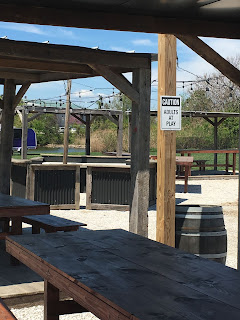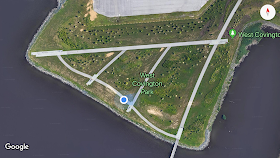Even though there may be the one or the other event that has trouble fitting into the 1.2 million square feet we can offer, the fixation on the size of the center is grossly misleading. Everyone who ever went to a convention knows that most convention organizers aim for a geographic mix while looking for the really cool cities where everyone wants to go. An attractive city with a stellar image boosts attendance and is the root of the business model.
 |
| The Baltimore Convention Center is bunker-like and blocked off by too many lanes of traffic |
Is Baltimore the city everyone wants to go? It certainly could be, just as much as Pittsburgh, New Orleans or Detroit, but it isn't and hasn't been for a while.
Its not only the overall image of Baltimore that is an obstacle ("is it safe?", "are they competent there?") but also the setting of the center itself, the nearby hotels and what one sees when stepping out the Convention Center!
The times when conventioneers wanted to check into a hotel and walk from their bed straight into the nearest ballroom presentation, without ever stepping outside, are over. Today most people come for the urban experience. Many organizers complement their program with tours and programs in nearby facilities that allow participants to get a whiff of their host city. Baltimore's Convention Center opens up to Pratt, Conway, Charles and Sharp Streets. Each street is duller than the next, in part because of the bleak facades of the Center itself, but also because the other side of the street not only doesn't look much better but also is utterly unreachable because of all the traffic. As such, the Convention Center not only fails to attract enough visitors, it is also a drag on the city. Just consider, how wonderfully the westside of downtown could flow into Otterbein without it!
Baltimore cannot be expected to compete with nearby "class A" convention locations such as NYC, Philly or DC. Instead we need to corner a market that isn’t in direct competition with those neighbors. Maybe in the "B market" to which Baltimore should cater the 1.2 million area it has is just fine, considering that the larger the center, the larger the potential dead-zone in the city it creates. 1.2 million square feet, if spruced up, are a lot of space!
 |
| Walking along here provides little pleasure. But it would be easy to fix this (photo: Philipsen) |
Just take Nashville: Because its a hip city on every list noted as "up-and-coming", they also built a brand new convention center for nearly a a billion dollars.
But the center in Nashville is compact with its 1.2 million sf, the same size we currently have. It looks attractive from almost any perspective and it easily hooks up with other nearby attractions such as their arena and the Bridgestone Arena and the Country Music Hall of Fame. It doesn't have any imposing port vehicle delivery areas, not in the front or the back.
The surrounding Nashville streets are lively most of the time and one can easily walk to Broadway and the various bars and restaurants. There is a lot of traffic in Nashville (they hardly have transit) but aside nothing roars directly by in the manner Pratt and Conway Streets where traffic has highest priority. No street next to Nashville's center is as dull as that block of Charles Street between Conway and Pratt which makes it impossible to imagine that the Inner Harbor is only a stone-throw away.
 |
| Face of the Nashville Convention Center: Outdoor terrace |
Of course, the Inner Harbor itself is tired. On the way to HarborPlace the recent added street level activity at the corner of Pratt and Light is welcome, but the devastated McKedlin Plaza and the back of the now marginal Light Street pavilion present only more barriers, far from exuding any coolness. (When was the last time that "Ripley's Believe or not?" was cool)?
Adventurous souls who want to explore downtown are certainly not enticed to do so. Venturing north from the Convention Center is no fun, no matter which route one tries: Eutaw or Howard Street, Hopkins Plaza, Charles, Light or Calvert Street. In each case at least the initial block is dreadful, often a lot more. Chief among deadening elements: Parking garages and surface parking lots. Equally awful for the much touted "pedestrian experience" are hotel loading zones, the brutalist facade of a fire-station with trucks blocking the sidewalk and the general lack of street trees, sidewalk cafes or retail.
Eying their options, conventioneers will inevitably amble towards the water's edge and stay there like caged animals. If they are persistent enough to not being deterred by parking lots and garages even in this most prestigious waterfront zone, or by interesting but impenetrable buildings like the Columbus Center and the condos of Scarlett Place, they will eventually find Harbor East and its smaller and livelier streets and restaurants, even though there is no way-finding to guide them there. Nothing tells them that even further out, along the promenade there would be also historic Fells Point, an area far more interesting than any section of Nashville. Yet there is no real promenade signage and walk access to Fells Point has been blocked by the Central Avenue bridge construction and the construction of the Whole Foods tower there for years. The walk route around HarborPoint is now possible thanks to the awful car-centric new bridge, but once again, there is no guidance and only insiders who know "Sandlot" would venture there.
 |
| Parking garage on the horizon: Why would one want to go here? And this is one of the better pathways north! |
Back at HarborPlace and the Convention Center, the entire freeway-ersatz network of Key Highway, Light, Pratt, and President Streets ringing the harbor is a deterrent for pedestrians ensuring visitors won't venture into the old downtown.
With just 63 annual events per the latest report, the Convention Center is far from fully booked. What should be done?
Sure, a few upgrades inside and on the facades of facilities would be good. A outdoor seating area along Convay Street on top of the awful plinth with the big exhibit halls below would be easy to do and potentially an attraction for ballpark visitors and conventioneers. The idea of combining a new arena with the convention center is creative and nobdy will cry about the loss of the Sheraton Hotel for this purpose.
Yet, nothing will work, as long as Baltimore continues to project incompetency, corruption and crime. Eeventually, Baltimore will become interesting again, in the same way New Orleans and Detroit worked their way out of the swamp. In the meantime a lot could be done to bring the areas surrounding the Convention Center up to snuff.
 |
| The Sheraton facing Conway Street: As pedestrian unfriendly as possible (Photo: Philipsen) |
To be perfectly clear for all those who say: Who cares? All those collateral improvements would foremost benefit Baltimore's residents. The benefit to visitors, conventioneers and the resulting economic impacts would be secondary.
In that, the convention center is, just like Pimlico, another example, that Baltimore's future isn't either for tourists or for residents (the typical binary approach), but the two are inextricably intertwined. In other words, the center can only recover when Baltimore recovers.
Klaus Philipsen
Related on this blog:
Convention Center:
is bigger really better?
Nashville 2018 Financial report
Nashville 2018 Financial report
 |
| Too much traffic, too many lanes and the pavilion as a barrier: Access to HarborPlace from the west. (Photo: Philipsen) |































